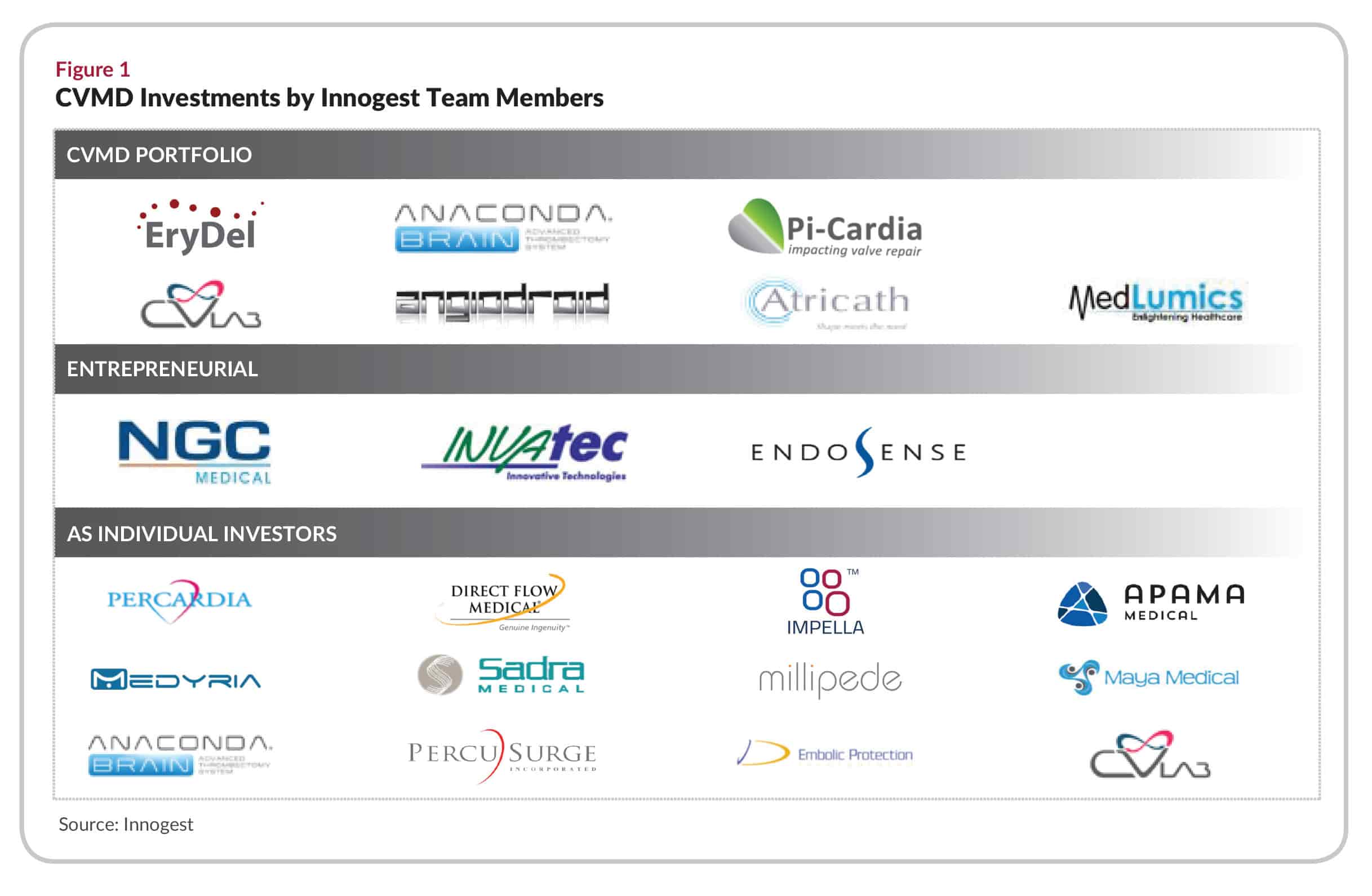ARTICLE SUMMARY:
Innogest Capital is the rare VC firm focused solely on one market: cardiovascular. To mitigate some of the risk inherent in that approach, it has created an incubator that will work on projects that are too early stage for Innogest and other potential investors.
Milan-based VC Innogest Capital defines its approach in terms of its clinical focus—cardiology—rather than stage of investment and will do deals from seed to late-stage. More, as Innogest’s next funds get larger, Claudio Giuliano, one of Innogest’s founders, says size alone may push it toward more late stage investing. To balance such a shift, implicitly if not explicitly, Innogest is shoring up its reach into early stage cardiovascular technologies with the launch of Cardiovascular Laboratory (CV Lab), a CV-focused incubator. Launched by Innogest, IP Group, and by angel investors Giovanni Leo and Andrea Venturelli in 2016, CV Lab named Marta Antonucci, a PhD in biomedical engineering, CEO in 2017. (Antonucci came to CV Lab after a long career with some of the largest cardiovascular multinationals, including Guidant, Boston Scientific, Thoratec and St Jude Medical; she had also worked at cardiovascular start-up, InControl, where she started her career.)
Technically, CV Lab is not part of Innogest, but rather is one of the portfolio companies in Innogest’s second fund. Antonucci says that the idea behind the incubator “is to get in very early on those opportunities that are just too early for the VC fund” to invest in, an idea that underlies most incubators today. “We thought, why not create an incubator that would take the ideas and with a moderate amount of money get them to the point of spinoff, with some proof of concept and maybe a team, when they would be ready for a VC fund to consider,” Antonucci says.
CV Lab incubates and nurtures the companies with an initial seed investment. Once that investment has been made, the incubator owns the project and will take it all the way to independence, a spin out from the incubator. And while CV Lab is itself based in Milan, “we’ve looked at projects from all over the world, Switzerland, Germany, France—we are completely geographic agnostic,” Antonucci says.
Antonucci insists that CV Lab is “completely independent in terms of the projects we take on and fund.” Indeed, she expects that CV Lab will raise funding for its spin-outs from other investors as well as Innogest.
In its early stages, CV Lab has relied on a network of advisors and entrepreneurs to tee up ideas and potential projects. And of course, Innogest is backing CV Lab because even for early-stage investor Innogest, the incubator projects are often too early to fund. That said, Antonucci insists that CV Lab is “completely independent in terms of the projects we take on and fund.” Indeed, she expects that CV Lab will raise funding for its spin-outs from other investors as well as Innogest. “There is absolutely no expectation nor right nor obligation that companies that we spin off will be invested by Innogest or any of our angel investors,” she says.
Because the incubator is less than two years old, any discussion of Innogest’s investment in companies coming out of CV Lab is premature. Currently there are several projects incubating in CV Lab, in areas including the treatment of aortic aneurysm and minimally-invasive cardiac surgery. Most of the ideas presented to the incubator have come from physicians and university researchers. Physicians, in particular, are a rich source, says Antonucci because “they see the problems and have an idea how they’d like to solve them.” At the same time, while a physician may have a solution to a clinical problem that vexes them, most often they don’t really know how to turn those ideas into reality or they have no desire to leave their clinical work to become full-time entrepreneurs, she says. Hence the need for an incubator.
Indeed, Antonucci notes that entrepreneurs who come to CV Lab with intact and experienced management teams are likely too late for the incubator. “That’s not our value proposition. Our value proposition is that we take the project from people who don’t know how to do it themselves and own it and take it forward.” People who come with patents in hand and a CEO “are more likely ready for our core fund or other funds,” adds Claudio Giuliano. The incubator is looking for those projects “that have been kept in a drawer,” because the physician or engineer simply didn’t know what to do next.
Selecting Deals
CV Lab has a target of keeping projects in the incubator between 12 and 18 months, hoping not to hold them longer. The goal is to have three or four projects going at any given time, though Antonucci says that number could go up as CV Lab grows.
“Nearer term, success will more likely be measured by the incubator’s ability to select projects that are able to spin out because “they meet the interest of somebody else,” Antonucci says.
Ultimately, as with any incubator, the success of CV Lab will be determined by how many companies it not only spins out, but how many of those successfully raise capital and, down the line, find acquirers or achieve some other kind of exit. Given how young the incubator is that metric is likely years away. Nearer term, success will more likely be measured by the incubator’s ability to select projects that are able to spin out because “they meet the interest of somebody else,” Antonucci says. “It attracts VCs or some other form of funding. Ideally, we want to do projects that have enough content to be a spinoff or that we can license out sooner to a strategic who will take it forward.”
Attracting other investors is important not just to CV Lab but to Innogest as well. Giuliano believes there’s a value in the discussions the incubator has with other VCs because those discussions expand the opportunity for projects in the incubator given the very real possibility that Innogest won’t invest in a particular project. Though both the incubator and venture fund share a focus on cardiovascular, “there will be [CV Lab] projects that are simply out of our scope,” he says.” We talk with them regularly and they talk with other investors regularly as well.” And that’s good. “Being independent means being independent. We don’t ever want there to be any question that this is a captive organization. That wouldn’t be good for CV Lab.” If within the next few years, Innogest were to invest in around one-third of all CV Lab spin outs, “that will be a fantastic outcome.”
Giuliano notes that historically, the VC firm has been “very much syndication-oriented, not only at the later stages, which is the norm, but at the very beginning as well.” But because of Innogest’s focus on cardiovascular, in the early stages, Innogest is more likely to turn to angels, hence the role at Innogest of partners and advisors like Paolo Cremascoli, Giovanni Leo, and Andrea Venturelli. Innogest also syndicates with the large, multinational cardiovascular device companies.
Innogest’s strategy rests on providing a kind of expertise in cardiovascular devices that more generalist VCs sometimes can’t.
In fact, Innogest’s strategy rests on providing a kind of expertise in cardiovascular devices that more generalist VCs sometimes can’t. Giuliano places a special emphasis on Innogest’s ability to recognize and source the right kind of projects to fund. “At the end of the day, our greatest expertise lies in selecting deals,” he says. “Around the world, a lot of companies start with their local VCs but eventually they seek our input. This is where we can be better than other VCs.”
Part of the Puzzle
Giovanni Leo notes that “there are many doctors who have ideas about [new technology] but they don’t want to stop being doctors. They’re very pleased to know that there’s someone they can turn their ideas over to and those ideas will get developed. It’s a nice concept, and we’re already seeing that it works.”
Nice concept, but incubators have historically proven difficult to do. For every successful one like The Foundry, Fjord Ventures, and MD Start, there are many more that launch with good ideas and even better intentions and don’t last past a cycle or two of innovation.
The main reason: the financial model is very difficult to pull off. Because incubators become involved so early in a project’s life—and very often fund or support in some way the earliest stages of development—resources for the incubator itself grow scarce as time goes on and the project lingers, needing more and more money at a critical point in the company’s evolution, while waiting for an exit that is increasingly elusive. Twenty years ago, time to exit for many medtech start-ups was five years; today, it’s closer to 10 years, if not more, and that’s a hard model to fund for most incubators. (See “FIRE1: A New Model for Early-Stage Device Incubation,” MedTech Strategist, October 10, 2014, and “MD Start: Building Medtech Companies in Europe,” MedTech Strategist, October 17, 2018.)
Claudio Giuliano notes that CV Lab is different from traditional incubators. “It doesn’t provide a facility for companies to evolve,” he says. “The concept is that there are ideas that would never see the light of day because doctors don’t know how to create a company or advance their ideas.” CV Lab helps them, he goes on, but “the idea is not to take them to an exit. It’s to take the company to the first financeable event.”
CV Lab can help mitigate the risk inherent in incubation by taking on projects of different complexity.
Still, this is a challenging time to be launching an incubator in Europe—add to the historic challenge of raising capital, Europe’s new regulatory reforms that some argue will have a dampening impact on innovation. “One of the virtues of the focus on cardiovascular is that the segment is “very broad,” Antonucci says. CV Lab can help mitigate the risk inherent in incubation by taking on projects of different complexity. “You have to be mindful of the mix of the projects you select,” she continues. “If you only have Class III projects, you’re going to be in trouble.” CV Lab will have some Class III projects, but also some Class I and Class II devices as well, “where time to return might be a little shorter,” says Antonucci. “When we see a Class III [device], we think long and hard about what the regulatory and clinical paths are. It’s a big part of the decision” whether to take on a project or not.
#Innogest #Dealmaking #MedicalDevice #CommunityBlog #Cardiovascular #medtech #medicaldevices #MedTechStrategist #VentureCapital #CompanyCreation #incubators
![]() Trial MyStrategist.com and unlock 7-days of exclusive subscriber-only access to the medical device industry's most trusted strategic publications: MedTech Strategist & Market Pathways. For more information on our demographics and current readership click here.
Trial MyStrategist.com and unlock 7-days of exclusive subscriber-only access to the medical device industry's most trusted strategic publications: MedTech Strategist & Market Pathways. For more information on our demographics and current readership click here.
